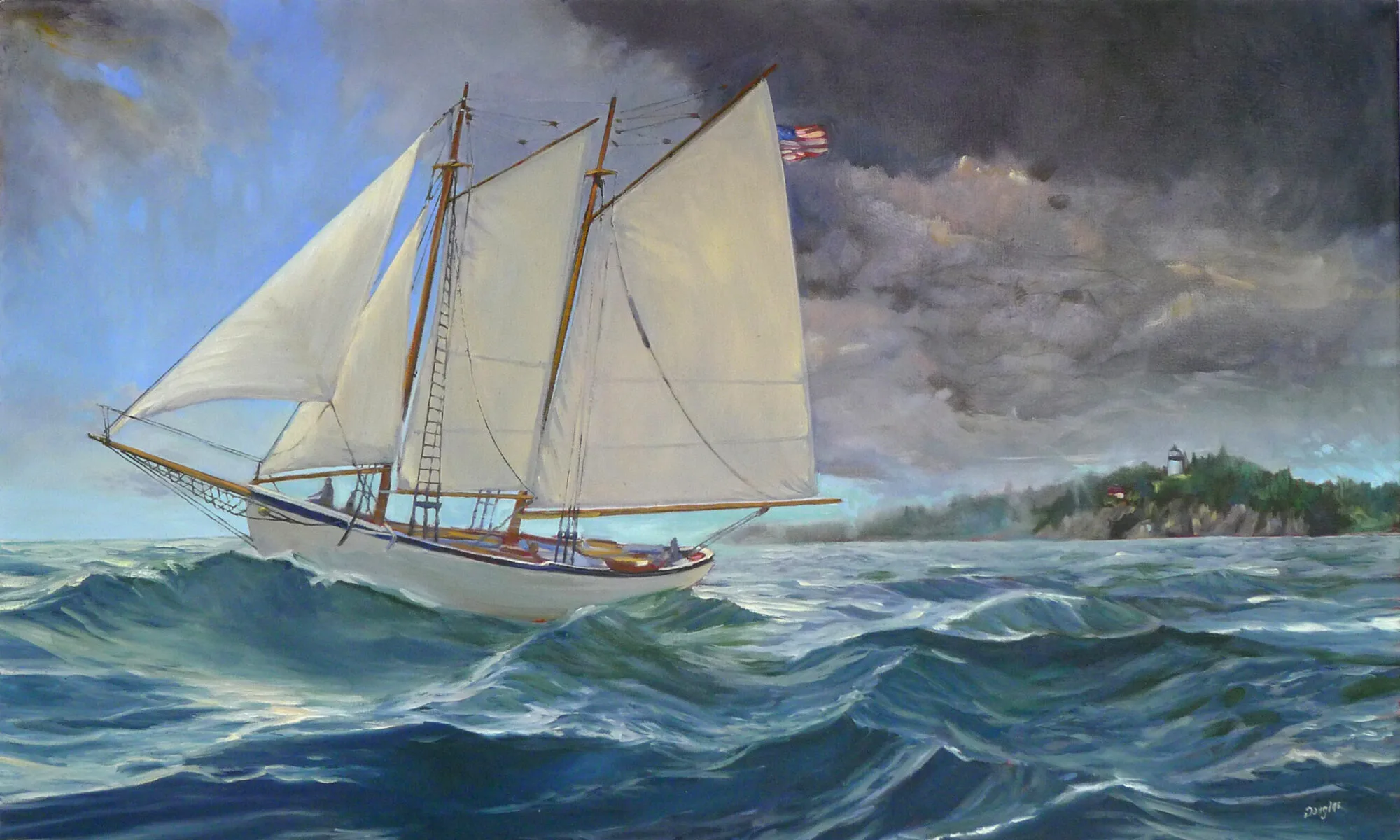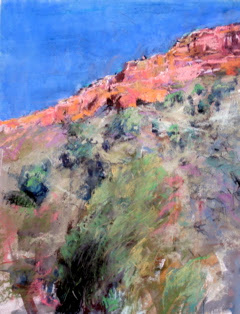John has posted his comments about the Adoration of the Magi in the Snow at The Shepherd’s Staff. He paints a wonderful word picture of Alabama which is well worth reading.
The Adoration of the Magi in the Snow
Oil on wood panel, dimensions not available
Oskar Reinhart Collection, Switzerland
My students have spent a lot of time in the past two months talking about composition. They would tell you that it is passing strange to have that Nativity on the edge of the canvas, partially obscured. Many critics have noted this and concluded that this is really a just a Flemish village scene with a Nativity tossed in. I disagree.
Pieter Bruegel’s birth was unrecorded, but it is thought to have been around 1525-30 in either Liège or Brabant. Just as there is ambiguity about his birthplace, there is no record of whether Bruegel died as a Protestant or Catholic. (He was shrewd—he asked his wife to burn his papers after his death.)
Bruegel’s youthful world was wholly Catholic. His training and early career were excellent and orthodox: apprenticeship to a leading Antwerp painter in the Italianate style (Pieter Coecke van Aelst), further studies with an artist-priest (Giulio Clovio) in Rome, a now-lost church altar in 1550-51. The anomaly was Coecke’s wife, Mayken Verhulst, an artist from Mechelin. This city was an early center for peasant genre painting, and she is sometimes credited with transmitting this idea to Bruegel. (She also trained his young sons after his early death in 1569; art history knows her mainly as the root of the Brueghel painting dynasty.)
Bruegel worked with three themes throughout his career: peasants, landscape and religion. In his early work, these converged and diverged in no particular pattern. As a member of a successful atelier family (he married the Coeckes’ daughter) he flourished; he had a high degree of skill as well. But his most brilliant paintings were at the end of his life. Was that simply because he had grown to maturity, or was he responding to the trials of his times?
One of the decrees of the Council of Trent was that religious painting must be suitably elevated; saints must be set apart from mere mortals in dress, demeanor and activity. The Church recognized that saints with dirty feet were a dangerous endorsement of the Protestant concept of a priesthood of all believers.
By then, Reformation was smoldering in the Netherlands; Anabaptists and Calvinists met secretly and illegally. Bruegel left no record of what he thought of this or anything else. But from a Catholic standpoint, his paintings became positively impertinent. Of these paintings, three deserve mention. Bruegel located his Tower of Babel (1563) in a Flemish city and dressed Nimrod as a European king. The Sermon of St. John the Baptist (1566) is militant—subversive, actually—because it clearly depicts a contemporary Calvinist or Anabaptist service. In it he identifies the heretic Protestant preachers with John the Baptist. The Adoration of the Magi of 1564 is a straight-up Nativity scene, but anything but saintly. Notice Mary’s droopy veil, Joseph’s distraction, and the brutish faces of the peasants to his right.
One could ask whether these reflected the views of his patrons or his own religious convictions. I would guess that the two were so intertwined that the question is meaningless. (One of Bruegel’s most important patrons was Cardinal Antoine Perrenot de Granvelle, a leading European statesman and Counterreformer, but if Caravaggio’s experience was an indicator, we shouldn’t read too much into that.)
How powerful art can be! In 1566, the Reformation ignited in the Low Countries. It did so over the issue of art, in the form of the Beeldenstorm (“picture storm”), in which church art was systematically destroyed throughout the Netherlands. Spain responded by sending the cruel Duke of Alba to Brussels (where Bruegel had settled) to extirpate the rebels. This reign of terror—in which thousands died and many more were dislocated—led directly to the Eighty Years’ War.
It was during the height of this terror that Bruegel painted The Adoration of the Magi in the Snow. It’s lovely, but it isn’t peaceful. The central stream of figures is very nearly on the march.
The Protestant impulse forced a new way of painting. Artists couldn’t produce idols, so the pattern books of their faith—unchanged for a millennium—were closed to them. How, then, could they articulate their religious feelings? Bruegel actually painted three winter scenes of the Biblical Infancy Narratives. The others are The Slaughter of the Innocents (1565-66) and The Census at Bethlehem (1566).
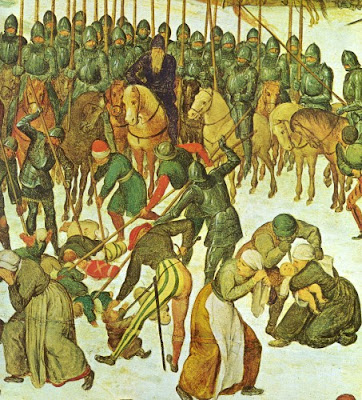 Slaughter of the Innocents, detail (1565-66)
Slaughter of the Innocents, detail (1565-66)
Pieter Bruegel the Elder
Oil on wood panel, dimensions not available
The Nativity (particularly the Virgin and Child) is the most commonly painted subject in art. Even in our secular age, even among non-Christians, it is universal. Bruegel’s brilliance was in realizing that he didn’t need to spell out the scene inside the stable; everyone knew it. In fact, in not doing so, he allowed us to regain something mysterious and personal about that night.
I must mention Bruegel’s technical prowess. Since he invented the winter landscape, he can also be credited with chromatic modeling in snow, in the form of violet shadows and the warm highlights. Note how the roof in the building on the top left is shaped by these shifts in color rather than with darker grey shadows. (This was an artistic choice; the snow on a dark winter day is generally flat.) The dark mass of people sweeps in an arc to the Nativity, pulling it back up into importance. Bruegel emphasized this sweep by making it the busiest part of his painting, and by making the figures darker and in greater contrast than the surround. This arc of humanity plays off against the perfectly composed diagonal lines of the surround.
A blessed Advent to you all.
Plein Air Taos 2008
I will teach plein air in Taos next June with Shelli Robiner-Ardizzone of New York. Here is some information about her previous trip to Taos. We will be sending materials out at the first of the year, but of course, if this trip is what you want for Christmas, contact me here.
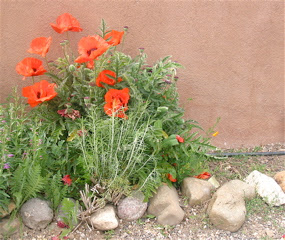 Poppies in a Taos yard , 2007
Poppies in a Taos yard , 2007Joan of Arc from a theological standpoint
My friend John has finished his essay about Joan of Arc on his blog, The Shepherd’s Staff. (see the prior post for details). Please visit his blog and see what he has to say…
Joan of Arc
John is a Baptist pastor from Alabama; I am an artist from New York. Can we find enough common ground in our Christian faith to make this work?
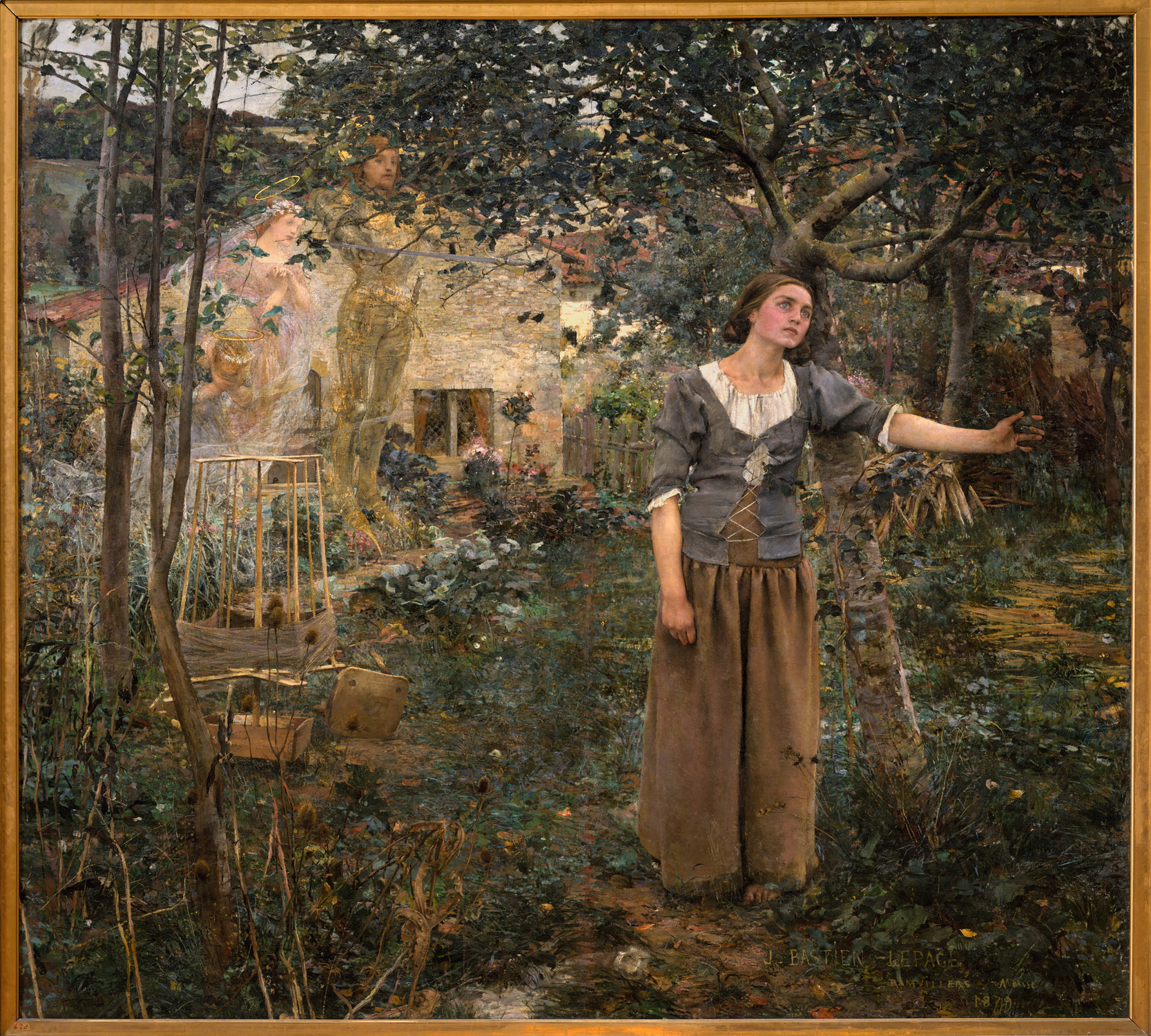
Joan of Arc, 1879, Jules Bastien-Lepage (French, 1848–1884)
Oil on canvas; 100 x 110 in. (254 x 279.4 cm)
The Metropolitan Museum of Art
Joan of Arc was born into a bleak moment in French history. France and England were entering the penultimate phase of the Hundred Years’ War. The English had captured huge swathes of territory and secured the French crown under the Treaty of Troyes, which also declared the Dauphin Charles VII illegitimate. The French countryside was bearing the brunt of a century of fighting, depredation, and the Black Death 75 years earlier.
At about age 13, Joan began to hear voices. Eventually, she sorted these voices to be those of St. Catherine of Alexandria, St. Margaret of Antioch, and the archangel Michael. These coalesced into visions. At her trial, she said: “I saw them with these very eyes, as well as I see you.”
By the time she was 16, her heavenly counselors had become more insistent and specific. She never recounted her visions at her trial, but there is a record of them that slightly predates the relief of Orléans. A Flemish diplomat named De Rotslaer recorded “that she would save Orléans and would compel the English to raise the siege, that she herself in a battle before Orléans would be wounded by a shaft but would not die of it, and that the King, in the course of the coming summer, would be crowned at Reims, together with other things which the King keeps secret.”
The story of her initial rejection (“Take her home to her father and give her a good whipping”) and eventual triumph is worth studying. Two details touch me. The first is that the Dauphin subjected her to a careful theological examination before entrusting his troops to her. The second is that her career ended abruptly after her visions were fulfilled.
Jules Bastien-Lepage was part of a movement in European art and literature known as naturalism. This embraced realism but often was invested with an awareness of the condition of the poor, which in some cases makes the art into manifesto (see Charles Dickens as an example). At the same time, the nineteenth century saw an enormous population shift from the countryside to the cities, so there are elegiac overtones in the genre.

Jean-François Millet (1814-1875)
Gleaners, also called, The Gleaners
Oil on canvas
Musée d’Orsay
(for a far better, copy-protected reproduction, see here)
Bastien-Lepage was temperamentally the heir of Jean-François Millet, who painted the incomparable Gleaners. About Millet, the Catholic Encyclopedia of 1913 said, “he has shown us how the trivial can be made to serve in the expression of the sublime, and how the Infinite and the Divine can be discerned in the humblest existence.” Vincent Van Gogh, Honoré Daumier, and Bastien-Lepage also had that sympathy, although it was tuned differently in each of them.
Bastien-Lepage painted Joan of Arc after the Franco-Prussian War. With their empire ruined and Alsace-Lorraine taken, the French identified powerfully with Joan. Bastien-Lepage’s painting is thus nationalistic, but to regard it as mere propaganda would trivialize it.
For one thing, there is the question of identification. Both the artist and the subject were from Lorraine. Joan was a peasant heroine and Bastien-Lepage was a peasant painter. She must have been an irresistible subject.

William-Adolphe Bouguereau
Tricoteuse, 1879
Owned privately
To understand the academic virtues of his painting, compare Joan of Arc to William-Adolphe Bouguereau’s Tricoteuse, painted the same year (Bouguereau vies with Caravaggio as the best painter of feet ever). The figures share the same perfection of drawing and modeling. But there the resemblance ends. In his best work, Bastien-Lepage used perfection only where it advanced his narrative, and there he pushed it to a photographic clarity—Joan’s loosely-laced jacket, the muddy shoes on the reaper. Bouguereau distilled detail to an ideal. His girl is an archetype of poverty, frozen in time.
In Joan of Arc, Bastien-Lepage introduced Catholic symbolism archaically, so we can almost read this painting like an icon. Joan’s own discarded spinning wheel (covered with wool so coarse we can practically smell it) stands in for St. Catherine’s wheel. Michael’s sword (Joshua 5:13–15) hovers in the air as a portent of the sword Joan would later find behind the altar in the chapel of Saint Catherine de Fierbois.
You can easily see Bastien-Lepage’s Impressionistic brushwork in the background of Hay Making, but it is also the device that allows the three saints to shimmer in Joan of Arc (we just can’t see it online). Moreover, he shoves us into the picture with Impressionist abruptness. We sense we’ve stumbled across Joan in her back garden. Compare this to Gleaners, which is profoundly powerful, but far more classical in its structure.
Nevertheless, Bastien-Lepage was not remotely an Impressionist. It is always Joan’s face to which I first respond. Her moment is awful in the deepest sense of the word. It is not that she has shut us out; instead, she seems to have stopped completely. Today many people see that frozen look as a failure, the result of painting from a reference photo. I disagree. It is a face of transfixion, of awed intelligence. After all, the face of the tedder in Hay Making, is hardly photographic, even though the painter was using the same technique. She is loose-jawed, beyond exhaustion.
This is where Bastien-Lepage diverges from the earlier naturalist painters. Millet saw nobility in the peasants’ suffering; Bastien-Lepage looked forward to the bleakness of the coming century. In the eyes of Joan and the tedder in Hay Makers, there are glimpses of the deep psychological pain of the German Expressionist Käthe Kollwitz.
Bastien-Lepage died young (at 36) and much of his work is either schmaltz or unformed. But some of it veers into greatness. I have to wonder what he would have produced had he lived longer.
(You can peruse Bastien-Lepage’s œuvre online here. You can read the transcript of Joan’s heresy trial here, and the nullification trial here.) In researching this, I also came across the delightful and idiosyncratic Hay in Art.)
The Opium Eater, Addendum
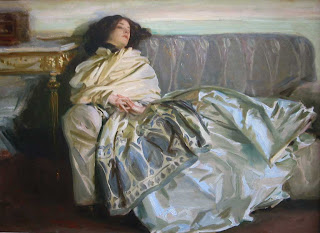
Repose (Nonchaloire), John Singer Sargent, 1911, National Gallery of Art, Washington DC http://jssgallery.org/Paintings/Repose_(Nonchaloire).htm
Again, look at the hands which bring tension into the pose.
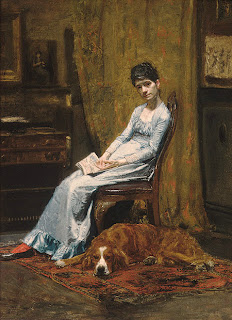
The Artist’s Wife and His Setter Dog, Thomas Eakins ca. 1884–89, Metropolitan Museum of Art
http://www.metmuseum.org/TOAH/hd/eapa/hob_23.139.htm
To me this is the most difficult position to paint. It’s easy to inadvertently make the figure rise in steps like a Ziggurat. That’s especially risky in this situation, where the gown stands so off so intensely from the background. Eakins twisted the torso slightly and further modified the blue shape with the shadows at the front of the skirt and the bodice, creating a lovely, flowing gown.
The Opium Eater
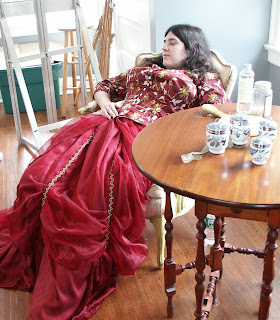 This week’s figure class featured Gail Kellogg Hope modeling a Civil War era gown of her own devising, minus the ruffled hoop. (Readers interested in historic clothing can see Gail’s work here.) Because Gail’s hair was down and she was recumbent, I thought she looked charmingly like a 19th century laudanum addict.
This week’s figure class featured Gail Kellogg Hope modeling a Civil War era gown of her own devising, minus the ruffled hoop. (Readers interested in historic clothing can see Gail’s work here.) Because Gail’s hair was down and she was recumbent, I thought she looked charmingly like a 19th century laudanum addict.
I wanted to begin this essay on languid poses with an American painting, but I was unable to find an American Victorian example. I’m not sure such a painting exists—it would have been contrary to our national myth to see womanhood as anything other than industrious, thrifty, and alert.
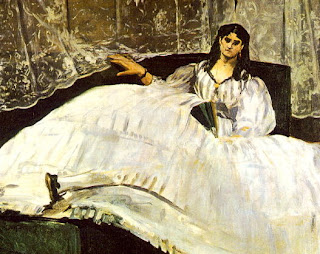 “Baudelaire’s Mistress Reclining,” Edouard Manet, 1862, Szépmüvészeti Museum, Budapest. http://cgfa.dotsrc.org/manet/p-manet35.htm
“Baudelaire’s Mistress Reclining,” Edouard Manet, 1862, Szépmüvészeti Museum, Budapest. http://cgfa.dotsrc.org/manet/p-manet35.htm 
“Lady Agnew of Lochnaw,” 1892-93, oil on canvas, The National Gallery of Scotland http://www.nationalgalleries.org/collection/online_az/4:322/result/0/5396?initial=S&artistId=4829&artistName=John%20Singer%20Sargent&submit=1
The fin de siècle painters were much more comfortable with slouching. I’ve included this example by Sargent largely because the chair resembles the one in my studio—before a century of wear and grime and burst seams. Sargent’s lady reclines, but she is anything but debauched. Instead, the pose is one of aristocratic grace. Although Lady Agnew levels her gaze at the viewer with the same assurance as Jeanne Duval, her chin is down and demure. Notice the right arm culminating in a firm grip—it belies the rest of the pose and points to why Sargent’s portraits are never dull.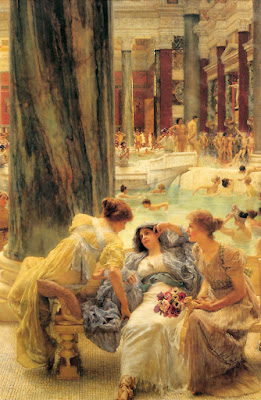
“The Baths of Caracalla,” Sir Lawrence Alma-Tadema, 1899, private collection http://www.artrenewal.org/asp/database/image.asp?id=610
Sir Lawrence Alma-Tadema was proof that not every Dutch painter was brilliant, although he gets my respect for being silly and exuberant. He was, of course, a fine technician. Although not strictly a Pre-Raphaelite painter, he shares with them the tendency to see women as sensual and emotional creatures. In this painting, his Roman matron sinks comfortably into a hard marble bench. Perhaps the background hints that these baths were built by Rome’s most psychotic emperor, but the matron’s couture, coiffure, coloring and companions are strikingly, calmly English. 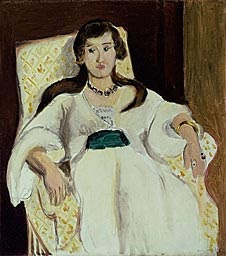
“The Green Sash”, Henri Matisse, 1919, Art Institute of Chicago http://www.artic.edu/aic/collections/citi/object?id=59919&artist=Matisse&keyword=
After that, it is a relief to return to the ambiguity of Matisse. This painting is austere; in fact it has a lot in common with the Manet above. There is no “setting” per se. As in the Manet portrait, the gown has presence and meaning of its own.
Note that in the portrait of Lady Agnew, Sargent is using Matisse’s patterns while in this painting Matisse is using Sargent’s beloved black paint.
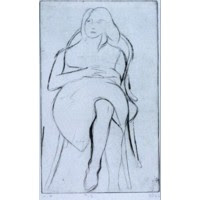
“#13 from the book, 41 Etchings Drypoints,” 1965, Richard Diebenkorn, Fine Arts Museums of San Francisco http://www.thinker.org/imagebase_zoom.asp?rec=6339304212900030
We recognize this last work immediately as a mid-century American drawing by the hemline and the hair. As cloying as that was with Alma-Tadema, it is a virtue in this etching by Richard Diebenkorn. Why is that?
With the hand resting on the abdomen, we have come full circle back to the photo of our model. There seems to be nothing strange about that pose to me, but will future viewers see it as an idiosyncrasy of our age?
Where the movie “Big” was filmed
The artists’ boards were stamped at 3 PM on Friday, since rain was threatening on Saturday morning. Daisy and I gathered our boards and lunches and headed to the Playland boardwalk. Playland was built in 1927 and is the only Art Deco amusement park left in the United States; it’s a National Historic Landmark. The part on which we painted is a public beach. (To learn more about Playland, see here.)
Many people pointed out that the section I chose to paint was
used in a scene in Tom Hanks’ Big. Does this look familiar?
The boardwalk and bathhouse are set on a long curve, which makes for some intriguing arcs. I stood within a stucco arch and focused on the long curving sweep of the roof. Even though the subject of the painting was the bathhouse with its two towers I knew the picture depended on the sweep of the blue roof.
By the time I committed my drawing to canvas, the light was gone. It was a beautiful evening, with lights twinkling along the boardwalk, but useless for painting.
The next morning I arrived in Rye shortly after 6 AM.
No box easel! I can never find anything in them.
My set-up under an arch was a good idea, for it was rainy, cold and dark.
My first task was to refine my drawing in charcoal. Normally, I don’t do much charcoal drawing, but the buildings are complex and I was working fast.
Daisy scoping out the scene…
It was hard to choose among the architectural gems in this place…
I concentrated on painting the orange beams first because I needed them to be believable.
Note that I got rid of the man peering into the Museum windows. I think that was a mistake—he lent good foreground interest. I replaced him with a couple walking a dog—ubiquitous on the boardwalk, but too far away to lend any depth to the scene.
The finished painting:
“Where Big was Filmed”
16X20, oil on Ray-Mar canvas board, sold, Rye, September 15, 2007
Voila! The new studio.
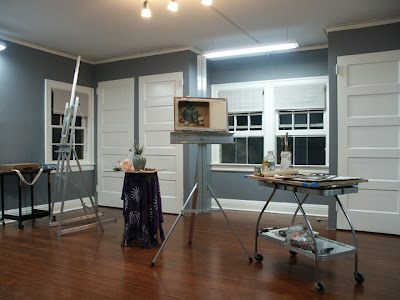 New studio space—spacious, with focus spots, color-corrected ambient lighting, and plenty of north daylight (when the sun is shining).
New studio space—spacious, with focus spots, color-corrected ambient lighting, and plenty of north daylight (when the sun is shining).
The project which consumed my August is finished. Here is my new teaching space, a lovely, calm, graceful room with great light. And here are my fall classes, for those readers in the Rochester area:
Studio in Art
Saturday, 10-1
Wednesday, 10-1
(Oil, pastel, acrylic, watercolor)
This class focuses on still life as a fundamental tool for developing drawing and painting technique. It is appropriate for both beginning and advanced students. Instruction emphasizes direct painting, where paint is applied solidly rather than through glazing. For watercolor and acrylic, the emphasis is on alla prima techniques.
$100/month
Figure
Saturday, 2-5
Wednesday, 2-5
(Oil, pastel, acrylic, watercolor, drawing media)
This class focuses on the figure’s relationship with the built environment. In addition to working with live models, we will study human anatomy, drapery and clothing. The class is suitable for both beginning and advanced students. Students without a background in figure drawing are encouraged to begin in charcoal.
$137.50/month
Five questions from Paul Abspoel
My friend Paul Abspoel (here) asked me five questions to be answered on this blog. I apologize for the time it’s taken, but here are the questions and the answers:
Please comment: ‘God is an Artist, but his art is not very accessible’
“Accessible” art has a message we easily grasp. Our response to Creation is visceral and consistent: from the molecular to the cosmic level we react with awe.
As the Book of Common Prayer says, “At your command all things came to be: the vast expanse of interstellar space, galaxies, suns, the planets in their courses, and this fragile earth, our island home. By your will they were created and have their being…”
Who do you consider to be the greatest Dutch painter: Rembrandt van Rijn, Johannes Vermeer, Vincent van Gogh, Pieter Mondriaan or Karel Appel? Tell us what you like about these famous Dutch painters and give us your explanation for the fact that there are so many artistic highpoints in the historic scenery of my flat little country.
Let us start with your last point—why your nation produced so many brilliant painters. Your weather (so damaging to frescoes and tempera) is the reason we have oil painting in the first place. It was developed by the Early Netherlandish painter Jan van Eyk.
Before there was the modern Netherlands, there were the Low Countries. This was the locus of northern Renaissance painting. There was a northern sensibility that was Protestant and Gothic, and which shaped a painting style that was intimate, naturalistic and religious. Unfortunately the Early Netherlandish painters are outside the purview of your question; they include many of my favorite artists.
Your country was birthed as a multicultural, polyglot nation. Flemish capitalists, Sephardic Jews and French Huguenots transformed sleepy Amsterdam into a wealthy world capital. That hybridization was similar to the one which created America, and it seems to work not only for commerce but for culture.
The Dutch Republic was unique in that your wealth was held by merchants and skilled tradesmen, not with the church or nobility. Your bourgeoisie’s tastes ran to portraits, still lives, landscapes and genre paintings, in an “accessible” style.
On to your painters:
I have often wondered how Rembrandt ever sold a single painting, since he cared so little for Dutch virtuosity. His sensitive character assessments, intentional gawkiness, and fluid brushwork were more suited to Romanticism than to his time.
Rembrandt’s work is often subject to crackpot theories of attribution. Art critics can’t believe that someone so great can be so awkward, but it’s essential to his work. There is a Rembrandt at the Frick called “The Polish Rider” (here) which has been the subject of raging debate about authenticity. I believe it is his, and it illustrates how his technical unevenness contributes to the greatness of his painting.
There are only 35 definitive Vermeers known, so we are blessed to have several in the United States. I am always struck by how tiny his canvases were, since he seems to open the window on entire lives.
Vermeer’s genius lies in the way he reins in his superlative skill. Not for him the luscious, overblown still lives of his peers. We understand that he could paint anything, so what he chose to paint matters. He was a brilliant narrator, opening a tiny window into a story or principle. My mother has had a print of “The Lacemaker” (here) hanging in her dining room for forty years; I appreciate the moral tale (diligence and concentration) but at the same time it is also a lovely painting.
There is another Golden Age painter I’d add to your list: Franz Hals. He is known for his virtuosity, and people assumed he painted in one fast pass. Recent analysis shows that he built his work up in the traditional manner and then applied loose brushwork at the top. His hardy, carousing Dutchmen match my inner vision of your country. His “Banquet of the Officers of the Civil Guard” (here) show how gifted he was, but his intimate portraits like this young knucklehead (here) are what I love the best.
Van Gogh is probably the single most important painter of the last two centuries. He stood between the Impressionists and the Expressionists but there is no easy label to affix to him. There is no theoretical detachment in his color study as with the Impressionists; there is no disregard for subject as with the Expressionists. His work was always yoked to drawing and composition, and it is a mistake to assume he worked in one pass, for his work was carefully considered and developed. His paintings were never intellectual exercises or mindless pastorals. He was not distorting reality, but rather painting his own reality.
I admire his landscape technique beyond words, but I also empathize with him as a failed missionary and preacher. There is no way I can pick an iconic painting for him so I will point out an unusual one: “The Good Samaritan” (after Delacroix, here).
Pieter Mondriaan was interested in Theosophy, which makes sense when considered along with his move from expressionism to intellectual color theory. His grids are nicer in life than as reproductions, since they have a hand-made quality that is lost in photos. They are, of course, beautifully composed. However, I would select the beautiful “Molen Mill” (here) as his iconic painting, even though it’s not what he is remembered for.
Unfortunately, Karel Appel doesn’t do a thing for me. Willem de Kooning was more sensitive, less retrograde, and had a better color sense. But neither belongs in a list of greatest Dutch painters. Sorry.
What is your favourite Psalm? Please also tell us why.
The 23rd. It’s short and memorable. The first three verses are a promise about the Kingdom of Heaven on this earth. The next two describe our special relationship with God. The last one points clearly to our resurrection, as it neatly segues from this life to the next.
What special qualities do you appreciate in your husband and children?
I met my husband at age 15, in high school. We have been married 27 years. He is a brilliant and talented man with utterly no hubris about him. He’s sacrificed a great deal of his personal ambition to support his family, but he’s stoic and uncomplaining. He is not a rigid thinker and therefore my best guide to working through a complex question. He is not particularly reverent, which makes him very funny. And he loves art and history, so we travel happily through life together.
My daughter Julia (18) is an outgoing, entertaining girl with the heart of a missionary. Laura (also 18) is introspective, intellectual, and very loyal. Mary (14) has the soul of an artist, and I think she is most like me: often in trouble, but with a good heart. Dwight (10) is too young to categorize, although I would describe him as affectionate, funny, and unusual.
Outside this interview, what’s the best question someone has ever asked you?
“Do you accept personal checks?”
